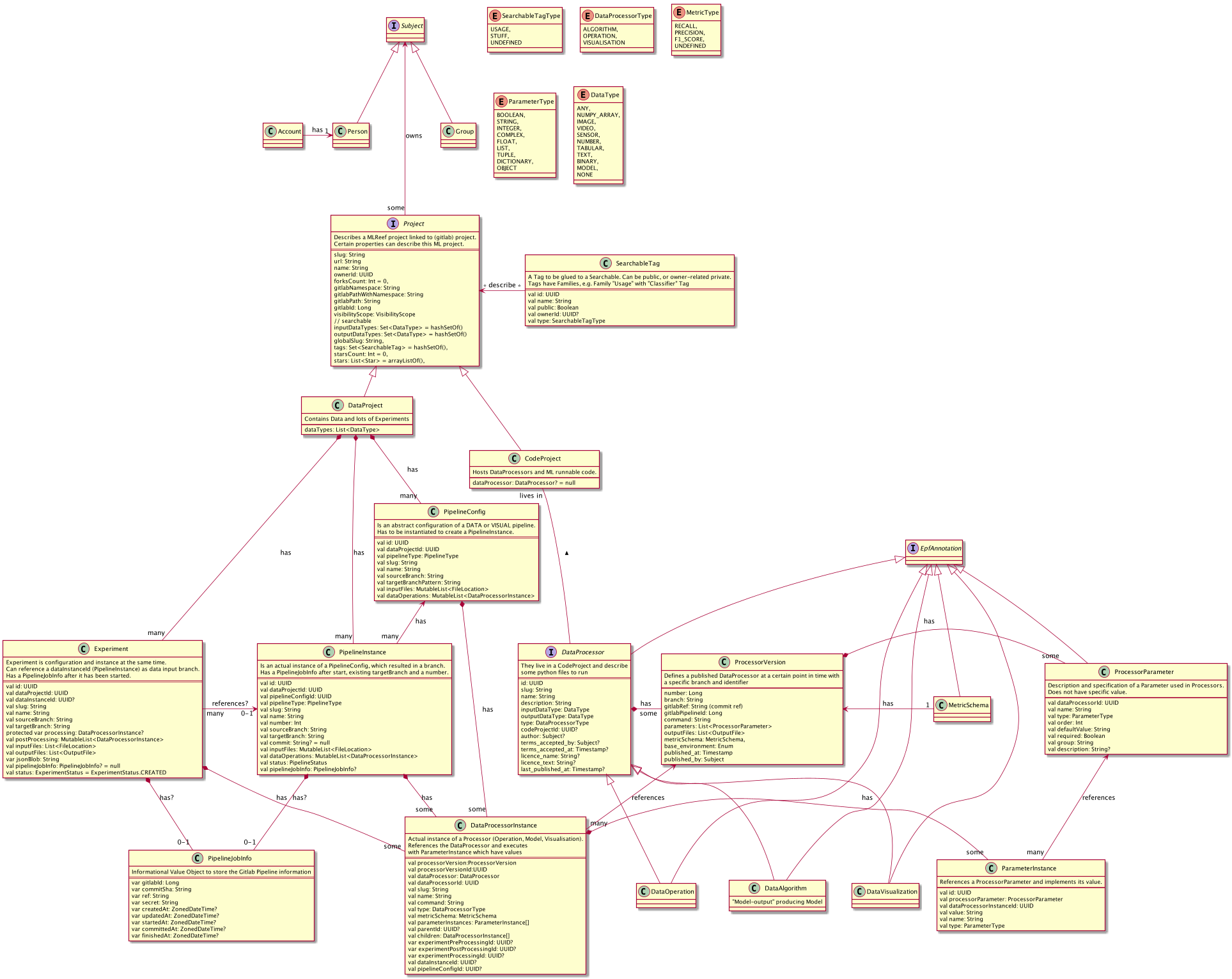Domain Model
In order to establish a big picture, the following model should use names which fulfill our need to understand the context.
UML Diagram
The following PlantUML export is the current draft and will be kept up-to-date.

Requirements
Python Library and EPF
We have to make sure, that users who want to integrate their scripts into the EPF context have an reliable API and convention to do so.
- We focus on "Developer Happiness" from the beginning. Annotating python files as EPF DataProcessors must be easy.
- Users must have a simple way to declare some basic descriptions
- Users can define their functions as DataProcessors in the MLReef context:
- DataOperation have at least: inputType, outputType
- DataVisualisation have at least: inputType
- DataAlgorithm have at least: outputType
- Parameters:
- Parameters of Processors must be definable
- Parameters are important, name, and typ is necessary, the order is not needed, as we use key=value syntax
- Parameters are nullable = false per default
- if nullable = true, a defaultValue must be annotated (the python function parameter itself does not need a default value)
From a technical point:
- The python file must be parsable by a Tool (lexical analysis) to extract the meta-information
- meta-information must be stored in the backend:
- DataProcessors must be created in respect to their owners and visibilityScope
- DataProcessors must be stored with their DataParameters
- If a DataProcessor is started, an Instance of DataProcessorInstance is started which has the following:
- A copy or association with the DataProcessor and its Parameters for this certain point in Time
- A list of instantiated DataParameterInstances with specific values
- Constraints:
- If the config of a DataProcessor gets changed, already existing DataProcessorInstances must not change
- If a DataParameter changes, already existing DataParameterInstances must not change
- Therefore, *Instances must associate with a persisted, audited version of the Parameter/Processor (when using SQL) or must copy the configuration and store it as a snapshost (when using noSQL)
- This smells like an UseCase for NoSQL, as we must act on different versions of Parameters/Processors all the time. This would be hard to archive with SQL (imho)
Example
@dataOperation(
name = "Resnet 2.0 Filter",
author = "MLReef",
decription = "Transforms images with lots of magic",
visibility = VisibilityScope.PUBLIC,
inputType = DataType.IMAGE,
outputType = DataType.IMAGE
)
@parameter(name = "cropFactor", type = ParapeterType.Float)
@parameter(name = "imageFiles", type = ParapeterType.List)
@parameter(name = "optionalFilterParam", type = ParapeterType.Integer, nullable = true, defaultValue = 1)
def myCustomOperationEntrypoint(cropFactor,imageFiles,optionalFilterParam=1):
print("stuff happening here")
// output is not exported via return, but rather as Files.
// we have to provide a way to store and chain outputs to the next input
myCustomOperationEntrypoint(epfInputArray)
Reads
- https://www.geeksforgeeks.org/decorators-with-parameters-in-python/
- https://github.com/antlr/antlr4/blob/master/doc/getting-started.md
Thoughts & Proposals
- We need a term for stuff like Data Operations, Data Visualisations, and Algorithms.
- They live in Code Repositories and have many things in common. As they are "things that run in an experiment and process/interpret data" they can be generalized as Data Processors
- It is still WIP, as e.g. DataOperations and DataVisualisation may behave similar from an API perspective
- Many Entities have global meaning, e.g. a DataOperation "Resnet" and also a one-time instance of that operation like "Apply Resnet with 40x40 params on this data"
- Those one-time instances will be called *Instance, and are needed for Parameters, DataProcessors and Experiments
- As Experiments are always Instances, the suffix is omitted.
- Instances exists in the context of an Experiment, as an Experiment "instantiates" DataOperations and run them in EPF
